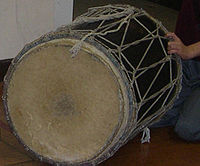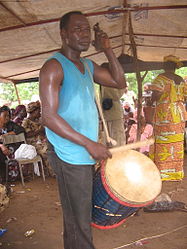- Dunun
-
Dunun
Dundun player at a Wedding ceremony in Bamako, MaliOther names dundun,doundoun, Classification Percussion instrument (membranophone Playing range Rope tensioned A Dunun (also known as dundun, doundoun, or djun-djun) is the generic name for a family of West African bass drums that developed alongside the djembe in the Mande drum ensemble. It is related in construction to the gungon or brekete bass drums of northern Ghana, except that the gungon uses a single snare on the drum face to produce a buzzing sound absent in the dunun. There are different sizes of dunduns, ranging from 25 to 60 cm. Basing on the size, construction technique and tuning, there are different names for each type of dundun. Some of the most often used names are konkoni, kenkeni, sangban, dununba, djeli-dun, etc.
Techniques
 doundounba from The Gambia
doundounba from The Gambia
There are two primary playing styles for dununs. The traditional style has each player using a single drum resting on its side, either on the floor or on a stand, and striking the head with one mallet and a bell mounted on top with the other. A melody is created across the interplay of the three dununs. For the other style, known as ballet style as it is used in the National Ballets, one player has command of the three dununs standing on the floor, allowing a more complex arrangement for the dance.
There are wide variations on how the dunun is played throughout West Africa. In Mali they are sometimes played with just one dunun and a bell that is held in the hand.
In some regions of Guinea the dunun is played with no bells, or only two dunun are played. In some regions of Mali up to five dunduns are played at the same time. In Hamanah, (Guinea) three dununs with bells are played. This style is one of the most known in the west, due to the influence of Mamady Keïta, Famoudou Konaté, Mohamed Diaby, Bolokada Conde, and other players from Guinea. It is formed of three dununs of different sizes; the kenkeni (smallest), sangban (medium) and dununba (largest). The kenkeni has the highest pitch and usually holds the rhythm together with a simple pattern. The sangban typically has a more complex part which defines the rhythm. The dununba often serves to add depth with deep, widely spaced notes. These drums provide a rhythmic and melodic base for the djembe ensemble.
In Bamako (Mali), a style of playing with two dunduns developed. Both so called konkoni, have goat skin and are played without the bell. The konkoni with the highiest pitch keeps the accompaining rhythm and the konkoni with the lowest pitch keeps the lead melody and solos.
In the Khasonke region of Mali, the biggest of the dunduns has the leading role - making solos and leading the song.See also
External links
Categories:- African drums
- West African musical instruments
Wikimedia Foundation. 2010.

